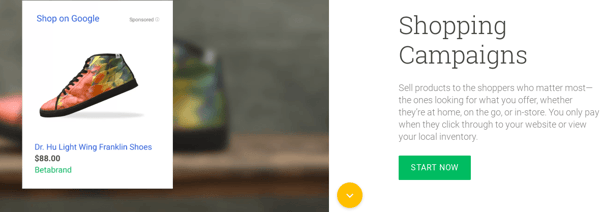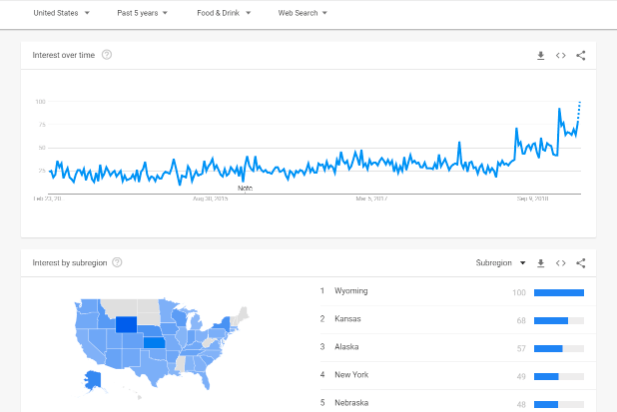In 2017, the consumer packaged goods industry generated over 90 percent of its growth from digital sales. The ratio of digital versus brick-and-mortar growth has marked a stark turning point for the industry.
However, the consumer goods industry has been slow to adapt to rapidly shifting buyer behaviors, preferences and retail channels, thereby leaving the vertical prime for disruption.
In fact, there are already numerous instances of such shifts in power due to the industry’s lack of innovation. For example, Dollar Shave Club’s online sales more than doubled that of industry titan Gillette’s in a mere three-year period:
“In January 2013, Gillette’s online sales were seven times Dollar Shave Club’s. By June 2016, Dollar Shave Club’s sales were more than twice the size of Gillette’s online.”
The industry is undoubtedly headed in a digital direction. According to research from the Food Marketing Institute, 49 percent of consumers are shopping for packaged goods online. Moreover, the firm predicts that by 2022, consumers will be spending over $100 billion on online food products. By 2025, online grocery will eat up 20 percent of all grocery sales.
It is clear that the tides are shifting rapidly. However, only a handful of retailers in the industry are adopting contemporary marketing strategies to inspire growth and maintain market influence.
To facilitate such goals, consumer goods retailers should look to the tenants of search engine marketing (SEM) as this discipline integrates numerous fruitful tactics for reaching consumers and driving sales.
Ready to take your consumer goods business to new heights? Check out these three powerful SEM strategies for consumer goods retailers.
1. Employ Google Shopping Ads

Google shopping campaigns have become an essential element for all online retailers. As it stands, Shopping ads generate over 85 percent of all Google Ads clicks and account for 76 percent of all retail ad spend. These ad campaigns are driving insane results for those that employ their powers.
However, when most marketers consider this ad type, the class of products that come to mind are electronics, clothing, footwear and similar offerings. Yet, this does not mean that these categories are the only ones that will yield results through these ads.
Retailers for books, furniture, jewelry and music, along with perishable items like food products, seemingly ignore this channel as a whole–and to their own detriment.
When analyzing Google Trends for terms like “online groceries,” more consumers than ever are searching such queries. Moreover, these searches are taking place all over the country, instead of in specific regions.

Consumer goods retailers have a massive opportunity to blaze a trail into this territory by utilizing Google Shopping ads as there is virtually no competition currently. Doing so can prove to be incredibly fruitful for driving traffic, increasing sales and building brand recognition online.
Moreover, the cost-per-conversion for such campaigns is poised to be remarkably low, given the minimal amount of competition.
While Google Shopping ads can potentially be an extremely beneficial boon for consumer goods retailers, there is much more to SEM than mere advertising.
2. Become Intimate with SEO
Search engine optimization (SEO), while often confused with SEM, is an essential component in search engine marketing.
Effective SEO strategies are vital to consumer goods retailers as the immense growth of direct-to-consumer brands utilizing subscription models provides merchants with a platform to get in front of consumers.
According to a study by McKinsey, consumer goods retailers utilizing subscription models are experiencing remarkable expansions:
“The subscription e-commerce market has grown by more than 100 percent a year over the past five years. The largest such retailers generated more than $2.6 billion in sales in 2016, up from a mere $57.0 million in 2011… [S]tart-ups have launched these businesses in a wide range of categories, including beer and wine, child and baby items, contact lenses, cosmetics, feminine products, meal kits, pet food, razors, underwear, women’s and men’s apparel, video games, and vitamins.”
These types of CPG brands are beginning to displace the in-store experience by offering consumers increased convenience and value. As a result, many of these brands’ customers go on to make repeat purchases.
To help gain notoriety with such a model, SEO is imperative. Therefore, the use of on-site copy optimization, blog content and other essential elements to an effective retail SEO strategy are vital.
For consumer goods merchants to get their products in front of the right shoppers, it requires:
- In-depth keyword research: Identifying ideal keywords can help surface brands for the right queries. Using tools such as SEMrush’s Keyword Research tool can uncover fruitful terms.
- Mindfulness of semantic search: With the rise of voice search, retailers must consider the way queries are changing in the way they are phrased. Think about terms that consumers are likely to speak out loud, not type.
- Craft long-form content: Content is the foundation of search engines and the backbone of all SEO strategies. Comprehensive content tends to perform best as it meets consumer needs for information while naturally incorporating targeted keywords.
- Build links authoritatively: In conjunction with producing outstanding content, conduct outreach campaigns to earn links and aim to attain placement in authoritative industry publications.
These points merely skim the surface of what must be done to rank well in Google’s SERPs. By taking a deep dive into the discipline of SEO, consumer goods retailers can begin to understand and implement strategies that can help them generate traffic and sales.
However, it is important to remember that Google isn’t the only game in town.
3. Advertise on Amazon
Amazon is a behemoth in the online retail space. No seller can ignore the platform’s influence. Therefore, when considering SEM, it is important to remember that not only is Amazon a search engine unto itself, but it is the preferred engine by shoppers.
As it stands, 54 percent of consumers go directly to Amazon when starting a product search. The other 46 percent start on Google. Moreover, Amazon earns five percent of all retail spend. With over 310 million active customers, Amazon can be a goldmine for consumer goods retailers.
As Amazon has vast reserves of information on its users, the company puts that data to good use through its advertising platform. While not as sophisticated as Google Ads (yet), Amazon is currently the third largest ad platform in the U.S. and features several powerful ad types that help merchants move products:
- Sponsored Products: These ads work much like the ones seen in the Google Display Network and often show above or below the Amazon search results. They can also surface on the carousel for similar product pages.
- Sponsored Brands: Formerly known as Headline Search ads, Sponsored Brands ads show at the top, bottom and sides of Amazon result pages. Moreover, these ads can feature multiple products.
- Product Display Ads: Product Display ads can surface in a multitude of places on Amazon’s platform; however, this ad type is only available to vendors. Therefore, it is necessary to have a vendor account with Amazon to leverage these ads.
Given that Amazon sells everything from electronics to supplements to groceries, this is an ideal destination for consumer goods retailers to integrate into their SEM strategies. Moreover, just like Google, it is essential for merchants to understand Amazon SEO best practices as this retail platform is essentially a search engine for products.
However, one of the most significant challenges of advertising on Amazon is that often the retail giant is in the bid as well. Given that Amazon sells its own proprietary products, there is a chance that merchants can lose out to the company’s offerings.
In the world of consumer goods, there are changes abound. It is essential for retailers to adopt new strategies on contemporary channels to survive the transition. Otherwise, a more innovative startup will replace those that fail to mature.
Leveraging search engine marketing best practices, consumer goods retailers can help eCommerce marketing strategies and learn to evolve with the times. Begin implementing these SEM practices, and your brand is likely to continue serving consumers far beyond those who fail to change.




